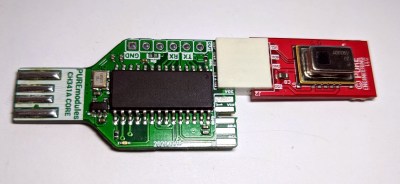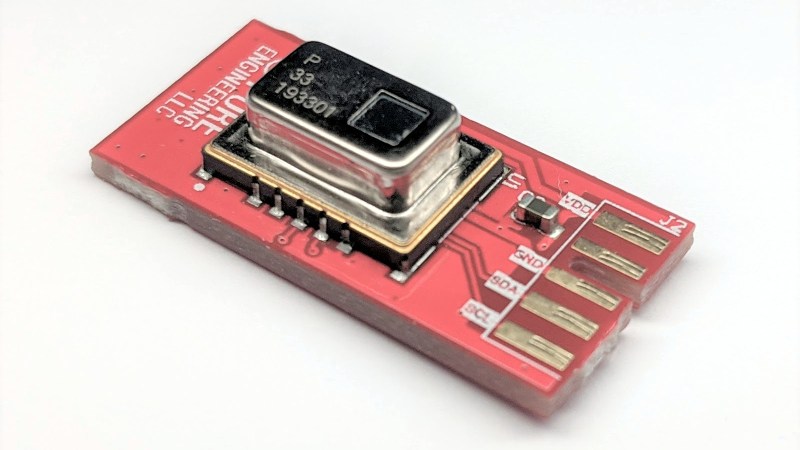Panasonic’s Grid-EYE sensor is essentially a low-cost 8×8 thermal imager with a 60 degree field of view, and a nice breakout board makes it much easier to integrate into projects. [Pure Engineering] has created an updated version of their handy breakout board for the Grid-EYE and are currently accepting orders. The new breakout board is well under an inch square and called the GridEye2 (not to be confused with the name of the main component, the AMG8833 Grid-EYE by Panasonic.)

A common way to interface with the Grid-EYE is over I2C, but to make connecting and developing on a PC more straightforward, [Pure Engineering] has made sure the new unit can plug right into their (optional) CH341A development board to provide a USB interface. Getting up and running on a Linux box is then as simple as installing the Linux drivers for the CH341A, and using sample C code to start reading thermal data from an attached GridEye2 board.
The Grid-EYE is a low-cost and capable little device that mates well with an LED matrix display, and on the more advanced side, a simple Gaussian interpolation can have a striking effect when applied to low-resolution sensors, making them appear higher resolution than they actually are.
















Wonder what the refresh rate is? Maybe a slow-scan type of reader.
Datasheet says 10 frames/sec
Some good info here: https://www.digikey.com/eewiki/display/Motley/Panasonic+Grid+Eye+Library+for+Atmel+Software+Framework
We were able to push it beyond 10FPS over I2C a few years back, but it wasn’t particularly stable.
I would.. If shipping to EU wasn’t twice the price of the module!
Can anyone tell me the type of connector that’s being used for the connection to the development board?
It looks similar to one of those clips used to connect LED strips together.
I’ve played around with these sensors, they are really interesting. I have an ongoing ambition to make one into a person detector, as opposed to standard PIR sensors that really only detect *movement* these sensors can potentially detect someone sitting still. With a Kalman filter to smoothly estimate foreground versus background the prototype I made was promising but I haven’t been able to finish it.
I’ve looked into this, and these sensors do not have enough accuracy. The best they can do is +/-2.5C or +/-4.5F. That’s not enough to get a temperature, but is good enough to detect a person. But great idea!
Hopefully this will be part of the game changers that make this type of sensor more economical. Right now forking out $55 for an 8×8 sensor is not going to happen. When the resolution goes up or the price comes down, they will be very interesting to play with.
Yeah. IR cameras like FLIR are a huge ripoff and it’s obvious monopoly/price fixing. there’s no reason for them to be this expensive. Looking forward to when they become cheap like CMOS sensors, etc.
Couldn’t you use a module with a CMOS and a IR Pass Bis block filter? I mean phone cameras can see IR.
Absolutely NOT. Silicon is transparent at LWIR range, and is typically used for large optical elements in thermal cameras due to the expense of Germanium. You usually need VOx pixels with a silicon readout chip under a vacuum encapsulation to see thermal radiation. The only thing you’re gonna see with CMOS and a bandpass filter is NIR, you can’t detect SWIR until you start using InGaAs arrays due to quantum efficiency dropoff
I’ve got one of the Panasonic dev board/Arduino shields in my drawer at work (a large national science museum), I wish I’d had the foresight to bring it home before everything kicked off because we’re now (predictably) talking about how to get visitors to interact with our stuff without touching anything and this could have some fun applications. There’s a blanket ban on procurement now (and my iron and meter are also in the office) so I’m having to do it all hypothetically and it’s driving me mad.